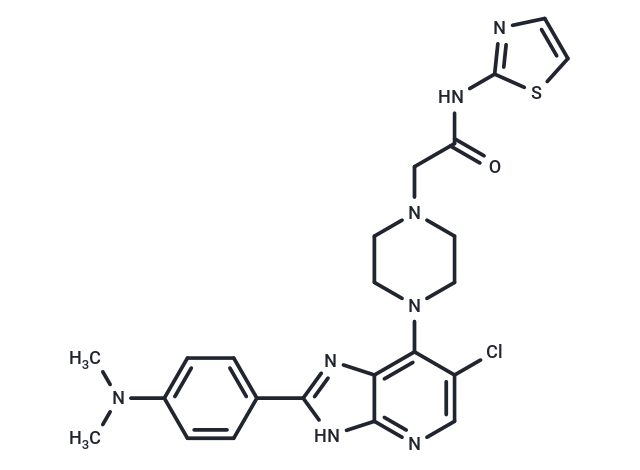Shopping Cart
Remove All Your shopping cart is currently empty
Your shopping cart is currently empty
CCT129202 is an ATP-competitive pan-Aurora inhibitor for Aurora A, Aurora B and Aurora C with IC50 of 0.042 μM, 0.198 μM and 0.227 μM, respectively. It is less potent to FGFR3, GSK3β, PDGFRβ, etc.

| Pack Size | Price | USA Warehouse | Global Warehouse | Quantity |
|---|---|---|---|---|
| 1 mg | $39 | In Stock | In Stock | |
| 2 mg | $54 | In Stock | In Stock | |
| 5 mg | $81 | In Stock | In Stock | |
| 10 mg | $150 | In Stock | In Stock | |
| 25 mg | $265 | In Stock | In Stock | |
| 50 mg | $425 | In Stock | In Stock | |
| 100 mg | $628 | In Stock | In Stock | |
| 500 mg | $1,350 | - | In Stock |
| Description | CCT129202 is an ATP-competitive pan-Aurora inhibitor for Aurora A, Aurora B and Aurora C with IC50 of 0.042 μM, 0.198 μM and 0.227 μM, respectively. It is less potent to FGFR3, GSK3β, PDGFRβ, etc. |
| Targets&IC50 | Aurora A:42 nM, Aurora C:227 nM, Aurora B:198 nM |
| In vitro | CCT129202 is an ATP-competitive inhibitor of recombinant Aurora A kinase with a Ki of 49.8 nM. CCT129202 at 1 μM shows high selectivity for Aurora A and Aurora B with 92% and 60% inhibition, respectively. It inhibits FGFR3 slightly by 27%, and is not active against CRAF. CCT129202 inhibits proliferation in multiple cultures of human tumor cell lines with half-maximal growth inhibition (GI50) values ranging from 0.08 μM for MV4-11 to 1.7 μM for MDA-MB-157. The effects are in association with increased expression levels of Aurora A and Aurora B leading to aberrant mitosis. Treatment with CCT129202 (0.7 μM) causes the accumulation of HCT116 cells with ≥4N DNA content, leading to apoptosis in a time dependent manner. Application of CCT129202 in HCT116 cells causes decreased histone H3 phosphorylation and increased p53 protein stabilization, which are consistent with the inhibition of Aurora B and Aurora A, respectively. CCT129202 induces up-regulation of p21 in HCT116, HT29 and Hela cells in a p53 dependent and independent manner, which leads to decreased phosphorylation of the Rb protein and activity of E2F in a concentration-dependent manner. [1] |
| In vivo | Administration of CCT129202 at 100 mg/kg in athymic mice bearing s.c. HCT116 colon cancer xenografts causes ~50% reduction of histone H3 phosphorylation after 30 minutes of treatment, and significantly inhibits tumor growth by 57.7% compared to control mice after a period of 9 days of treatment. [1] |
| Kinase Assay | Inhibition of Aurora Kinases: NH2-terminal glutathione S-transferase (GST)-fusion recombinant human Aurora A (aa 118-403), Aurora B (full length), and Aurora C (full length) are expressed in baculovirus, purified, and used in the kinase inhibition assays. The in vitro kinase assays are performed in kinase buffer (50 mM Tris pH 7.5, 10 mM NaCl, 2.5 mM MgCl2 and 1 mM DTT) containing γ-32P-ATP, Aurora kinase and different concentrations of CCT129202. The reactions are incubated for 30 minutes at 30 °C and stopped by adding sample buffer. The reactions are separated on Novex Tris-Glycine gels and dried on a vacuum gel drier at 80 °C for 1 hour before exposure to Kodak-Biomax XR film. The concentration of CCT129202 that inhibits Aurora kinases by 50% is calculated representing IC50 value. |
| Cell Research | Cells are treated with a range of 0 to 50 uM of CCT129202 for 72 hours. Cell proliferation is analyzed with the colorimetric 3-(4,5-dimethylthiazol-2-yl)-2,5-diphenyltetrazolium bromide (MTT) assay. The absorbance is measured at 570 nm using the Wallac VICTOR2TM 1420 Multilabel Counter.(Only for Reference) |
| Molecular Weight | 497.02 |
| Formula | C23H25ClN8OS |
| Cas No. | 942947-93-5 |
| Smiles | CN(C)c1ccc(cc1)-c1nc2c(N3CCN(CC(=O)Nc4nccs4)CC3)c(Cl)cnc2[nH]1 |
| Relative Density. | 1.427 g/cm3 |
| Color | Yellow |
| Appearance | Solid |
| Storage | Powder: -20°C for 3 years | In solvent: -80°C for 1 year | Shipping with blue ice/Shipping at ambient temperature. | ||||||||||||||||||||
| Solubility Information | DMSO: 4.98 mg/mL (10.02 mM), Sonication is recommended. | ||||||||||||||||||||
Solution Preparation Table | |||||||||||||||||||||
DMSO
| |||||||||||||||||||||
| Size | Quantity | Unit Price | Amount | Operation |
|---|

Copyright © 2015-2025 TargetMol Chemicals Inc. All Rights Reserved.